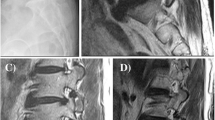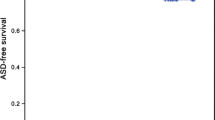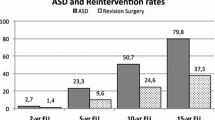Abstract
Purpose
To investigate: (1) the risk factors for radiologic cranial adjacent segment degeneration (ASD) after single-segment PLIF at the same level, and (2) the impact of the ASD on the clinical outcomes.
Methods
From October 2004 to May 2009, 109 patients who underwent PLIF for degenerative instability at L4/5 and have more than 2 years follow-up were studied retrospectively. We measured the preoperative bone mineral density (BMD), lumbar lordosis, the lumbosacral joint angle, the lumbar inclination, the height and the dynamic angulation of the intervertebral space at the fused segments and the upper adjacent segment, the sliding displacement between L3 and L4. Clinical outcomes were evaluated using the Japanese Orthopedic Association (JOA) score and the Oswestry Disability Index (ODI). Patients were divided into two groups according to the progression of L3–L4 degeneration: Group A without progression of L3–L4 degeneration, Group B with progression of L3–L4 degeneration. Clinical outcomes and radiologic measurement index between the two groups were compared, and the risk factors for progression of L3–L4 degeneration were analyzed. The correlation between clinical outcomes and progression of L3–L4 degeneration were also investigated.
Results
There were 11 patients (22%) classified into Group A. No significant difference was found between the two groups in terms of the lordosis angle at L1 and S1, the laminar inclination at L3, the pre-existing L3–L4 disk degeneration, the lordosis angle of L4–L5, the lumbosacral joint angle and preoperative BMD (P > 0.05). Significant differences were found between the two groups in age. No significant difference was found between the two groups in the ODI and the JOA score at the final follow-up (P > 0.05).
Conclusion
Radiologic degeneration of the cranial adjacent segment after single-segment PLIF did not significantly correlate with clinical outcomes. Age was a risk factor for radiologic degeneration, however, there was no significant correlation between degeneration and preoperative radiologic factors and bone mineral density (BMD).


Similar content being viewed by others
References
Okuda S, Oda T, Miyauchi A et al (2008) Lamina horizontalization and facet tropism as the risk factors for adjacent segment degeneration after PLIF. Spine 33:2754–2758
Park P, Garton HJ, Gala VC et al (2004) Adjacent segment disease after lumbar or lumbosacral fusion: review of the literature. Spine 29:1938–1944
Zencica P, Chaloupka R, Hladíková J et al (2010) Adjacent segment degeneration after lumbosacral fusion in spondylolisthesis: a retrospective radiological and clinical analysis. Acta Chir Orthop Traumatol Cech 77:124–130
Kumar MN, Jacquot F, Hall H (2001) Long-term follow-up of functional outcomes and radiographic changes at adjacent levels following lumbar spine fusion for degenerative disc disease. Eur Spine J 10:309–313
Battie MG, Videman T, Parent E (2004) Lumbar disc degeneration: epidemiology and genetics influences. Spine 29:2679–2690
Lee CS, Hwang CJ, Lee SW et al (2009) Risk factors for adjacent segment disease after lumbar fusion. Eur Spine J 11:1637–1643
Quinell RC, Stockdale HR (1981) Some experimental observations on the influence of a single floating fusion on the remaining lumbar spine. Spine 6:263–267
Yang SW, Langrana NA, Lee CK (1986) Biomechanics of lumbosacral spinal fusion in combined compression-torsion loads. Spine 11:937–941
Boden SD, Davis DO, Dina TS et al (1990) Abnormal magnetic-resonance scans of the lumbar spine in asymptomatic subjects. J Bone Joint Surg Am 72:403–408
Ghiselli G, Wang JC, Hsu WK et al (2003) L5–S1 segment survivorship and clinical outcome analysis after L4–L5 isolated fusion. Spine 28:1275–1280
Yamamoto T, Ohkohchi T, Ohwada T (1998) Clinical and radiological results of PLIF for degenerative spondylolisthesis. J Mus Res 2:181–195
Nagaosa Y, Kikuchi S, Hasue M (1998) Pathoanatomic mechanisms of degenerative spondylolisthesis: a radiographic study. Spine 23:1447–1451
Greenough CG, Fraser RD (1992) Assessment of outcome in patients with low back pain. Spine 17:36–41
Hirabayashi K, Watanabe K, Wakano K (1983) Expansive open-door laminoplasty for cervical spinal stenotic myelopathy. Spine 8:693–699
Bastian L, Lange U, Knop C et al (2001) Evaluation of the mobility of adjacent segments after posterior thoracolumbar fixation: a biomechanical study. Eur Spine J 10:295–300
Chen CS, Cheng CK, Liu CL (2002) A biomechanical comparison of posterolateral fusion and posterior fusion in the lumbar spine. J Spinal Disord Tech 15:53–63
Umehara S, Zindeick MR, Patwardhan AG et al (2000) The biomechanical effect of postoperative hypolordosis in instrumentated lumbar fusion on instrumented and adjacent spinal segments. Spine 25:1617–1624
Yang JY, Lee JK, Song HS (2008) The impact of adjacent segment degeneration on the clinical outcome after lumbar spinal fusion. Spine 33(5):503–507
Djurasovic MO, Carreon LY, Glassman SD et al (2008) Sagittal alignment as a risk factor for adjacent level degeneration: a case–control study. Orthopedics 31(6):546
Kumar MN, Baklanov A, Chopin D (2001) Correlation between sagittal plane changes and adjacent segment degeneration following lumbar spine fusion. Eur Spine J 10:314–319
Cho KS, Kang SG, Yoo DS et al (2009) Risk factors and surgical treatment for symptomatic adjacent segment degeneration after lumbar spine fusion. J Korean Neurosurg Soc 46:425–430
Aota Y, Kumano K, Hirabayashi S (1995) Postfusion instability at the adjacent segments after rigid pedicle screw fixation for degenerative lumbar spinal disorders. J Spinal Disord 8:464–473
Cheh G, Bridwell KH, Lenke LG et al (2007) Adjacent segment disease following lumbar/thoracolumbar fusion with pedicle screw instrumentation: a minimum 5-year follow-up. Spine 32:2253–2257
Ekman P, Mo¨ller H, Shalabi A et al (2009) A prospective randomised study on the long-term effect of lumbar fusion on adjacent disc degeneration. Eur Spine J 18:1175–1186
Seitsalo S, Schlenzka D, Poussa M et al (1997) Disc degeneration in young patients with isthmic spondylolisthesis treated operatively or conservatively: a long-term follow-up. Eur Spine J 6:393–397
Conflict of interest
None.
Author information
Authors and Affiliations
Corresponding author
Additional information
B.-L. Chen and F.-X. Wei contributed equally to this work.
Rights and permissions
About this article
Cite this article
Chen, BL., Wei, FX., Ueyama, K. et al. Adjacent segment degeneration after single-segment PLIF: the risk factor for degeneration and its impact on clinical outcomes. Eur Spine J 20, 1946–1950 (2011). https://doi.org/10.1007/s00586-011-1888-1
Received:
Accepted:
Published:
Issue Date:
DOI: https://doi.org/10.1007/s00586-011-1888-1




